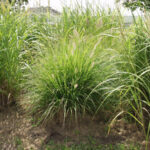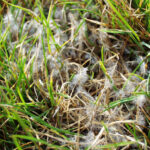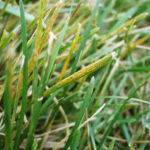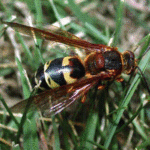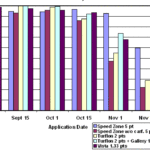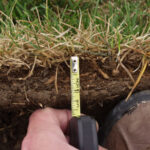Homeowner
Keep mowing and don’t set the mower down
Many people ask how long to continue mowing into the fall. The answer is to keep mowing as long as the grass continues to grow which is normally into late October or early November. Frequency of mowing can decrease but continue to mow into the fall. Also avoid the urge to set the mower down […]
Keep mowing to mulch those tree leaves!
The trees are dropping their leaves and it is important to prevent a heavy layer of leaves from building-up on your turf before winter. Heavy layers of tree leaves will shade the grass can smother and kill grass yet this fall. Plus tree leaf cover favors a damaging winter turf disease called snow mold. The […]
Poly Tanks for Farm Businesses Preventing Catastrophic Failures (PPP-77)
Purdue Extension Publication
High-density polyethylene tanks have been used successfully by growers and commercial pesticide application businesses for years. While the benefits of poly tank ownership are well established, the risk of tank failure is real. Like any piece of equipment, poly tanks need to be inspected and maintained to ensure that the benefits of use outweigh the risk of tank failure and product release.
Openings still available for MRTF Golf Day on September 30
Openings are still available for the MRTF Golf Day at The Fort Golf Resort in Indianapolis on September 30. We also have the opportunity for you or your company to sponsor a tee sign. More information on sponsorship and a PDF registration form can be found at www.agry.purdue.edu/turf/events/golfday.html or register on-line at http://mrtf.org/php/education.php#Golf. If you have any questions […]
Controlling escaped fountaingrass in a lawn.
Fountain grass and other ornamental grasses have added tremendously to landscapes of homes, commercial sites, and golf courses. However, we are now seeing some of these grasses escape from the ornamental beds into the turf. One in particular is fountain grass (Pennisetum spp) because it produces viable seeds which blow into surrounding turf and may […]
Pesticides and Personal Protective Equipment (PPP-38)
Purdue Extension Publication
Decisions about personal protective equipment (PPE) are challenging for pesticide users on farms and in gardens, pest control businesses, and greenhouses. This publication discusses the links between safety, attitude, and organizational philosophy; explains why PPE is necessary; offers general guidance on selecting PPE; and provides suggestions for care of PPE.
Cool temperatures allow a jump on beneficial fall maintenance practices
The recent record or near record low temperatures combine with adequate soil moisture is advantageous for our cool-season turfgrasses, especially compared to the typical August-September heat and drought. Fall fertilization can begin anytime, especially with rain in the forecast to help water in the application. White grub damage will likely be minimal with overall health […]
Damping off diseases in new seedlings
Although the cool weather tends to limit disease in new seedlings, a spike in the temperatures could trigger outbreaks in juvenile turf yet this year. Late summer is clearly the best time of the year to seed for a variety of reasons, but we must deal with two difficulties of seeding at this time: Our […]
MRTF Golf Day at The Fort in Indianapolis on September 30
Openings are still available for the MRTF Golf Day at The Fort Golf Resort in Indianapolis on September 30. This annual event is held to promote turfgrasss research, raise awareness of the Purdue Turfgrass Science Program, and provide an enjoyable day of golf. With a centralized location and afternoon shotgun start we hope to draw […]
Drought affects all turf areas differently
We are fielding a number of calls like “Why is my lawn is turning brown while my neighbors isn’t, even though neither of us irrigate?”. On any given turf area or in a neighborhood, we can see a wide variety of responses to the current drought. Following is a list of factors that will affect […]
Now is the Time to Start Improving Your Lawn
Tired of the way your lawn looks? If it hasn’t looked up to par this summer with the relatively good weather, it never will and reseeding your lawn is an option. Mid-August is the best time to seed a new lawn or overseed an existing lawn. If the lawn is just thin and needs a […]
Dollar Spot
Dollar spot is caused by a fungal pathogen, Sclerotinia homoeocarpa, that blights leaf tissues but does not affect turfgrass roots or crowns. The disease is a common concern on golf course turf, especially creeping bentgrass and annual bluegrass greens, tees, and fairways, where it can result in poor turf quality and appearance. Dollar spot is one […]
Rust Diseases
Rust is a disease of taller mown turf. Outbreaks are most common on residential lawns, low budget athletic fields, and, occasionally, on golf course roughs. A variety of related fungi cause rust. Ccommon names include leaf rust, crown rust, and stem rust, and the disease occurs almost exclusively on Kentucky bluegrass and perennial ryegrass. Rust […]
Cicada killers: A Nuisance or a Danger?
A number of solitary bees and wasps reside in turfgrass and landscapes. Because of their ability to harm humans, these insects often evoke a great deal of anxiety. However, in reality they very rarely sting. Education is the single best strategy to help people deal with cicada killers. Cicada killers are one of the largest […]
Securing The Load (PPP-75)
Purdue Extension Publication
Losing cargo on the road is serious business. The proper loading, positioning, and securing of cargo on a truck or trailer can prevent accidents in transit. This publication refers to government securement regulations and describes proper techniques for securing cargo on farm and commercial trucks and trailers.
Goosegrass control is difficult in sports and golf turf
Goosegrass is a warm-season annual very similar to crabgrass, but germinates later than crabgrass and is tougher to control with both pre- and postemergence herbicides. It is most common in compacted, heavily used, poorly drained, and/or thinned turf, so cultural practices to help alleviate these conditions are essential. With low populations, cutting goosegrass out with […]
Controlling ground ivy and/or violets
As lawns start to thin from summer heat, ground ivy and violets begin to overtake the turf especially insahded areas. These two weeds remain tough to control in Indiana. Even though applications now can produce visible damage, long-term control does not compare to fall applications. We have been working on ground ivy for a number […]
The somewhat random world of herbicide burn injury on turf
With weather drying out and heating up, the risk of herbicide burn is increasing. In most cases, herbicide burn is similar to fertilizer burn in that the concentration of the herbicide spray residue on the leaf literally sucks the water out of the leaf, desiccating the leaf. This is similar to how urea fertilizer spilled […]
White Grub Biology and Control in Espanol
In response to requests from our industry, we will be teaching a workshop in Spanish at Field Day on July 21. “White Grub Biology and Control” will be taught by Victoria Caceres from the Department of Entomology. This is a great opportunity for you or any of your staff who are comfortable learning in Spanish […]
Patch Disease Symptoms Starting to Show in Dry Kentucky Bluegrass Lawns
Summer patch and necrotic ring spot are root-infecting diseases in Kentucky bluegrass lawns. Their symptoms are some of the most difficult to manage, much less control the disease. Although these diseases differ slightly in when they attack the roots, the pathogens generally are active in the late spring to early summer. Infection-impaired roots have a […]

